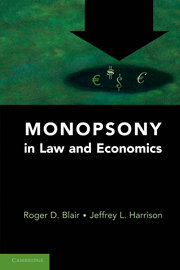Book contents
- Frontmatter
- Contents
- Preface
- ONE Introduction
- TWO The Antitrust Laws and Monopsonistic Forms of Conduct
- THREE Economic Theory of Monopsony
- FOUR The Antitrust Response to Monopsony and Collusive Monopsony
- FIVE Cooperative Buying Efforts
- SIX Bilateral Monopoly
- SEVEN Monopsony and Antitrust Enforcement
- EIGHT Monopsony in Action: Agricultural Markets
- NINE Monopsony in Action: The NCAA
- TEN Monopsony in Action: Physician Collective Bargaining: Monopoly or Bilateral Monopoly
- ELEVEN Final Comments
- Bibliography
- Index
FOUR - The Antitrust Response to Monopsony and Collusive Monopsony
Published online by Cambridge University Press: 05 June 2012
- Frontmatter
- Contents
- Preface
- ONE Introduction
- TWO The Antitrust Laws and Monopsonistic Forms of Conduct
- THREE Economic Theory of Monopsony
- FOUR The Antitrust Response to Monopsony and Collusive Monopsony
- FIVE Cooperative Buying Efforts
- SIX Bilateral Monopoly
- SEVEN Monopsony and Antitrust Enforcement
- EIGHT Monopsony in Action: Agricultural Markets
- NINE Monopsony in Action: The NCAA
- TEN Monopsony in Action: Physician Collective Bargaining: Monopoly or Bilateral Monopoly
- ELEVEN Final Comments
- Bibliography
- Index
Summary
Introduction
This chapter is about the antitrust response to monopsony and collusive monopsony. In some instances, it is possible to rely on actual examples of litigation involving monopsony power. In other scenarios involving monopsony and collusive monopsony conduct, however, judicial experience may be limited or nonexistent. In those areas, the judicial response can only be inferred from the judicial treatment of analogous behavior by firms on the selling side of the market. In both cases – actual or inferred judicial response – an evaluation is presented based on economic principles.
By way of preview, the actual judicial responses to monopsony generally make economic sense. In the opinions that are available, this may seem surprising since many of these opinions followed bright-line rules developed before economic principles were expressly applied to antitrust analysis. In this chapter, a modern economic foundation for these cases is offered as is a framework for analyzing monopsony practices that are yet to be addressed. In the process, we demonstrate that abuses by monopsonists and collusive monopsonists have not always taken the form suggested by the traditional models examined in Chapter 3.
- Type
- Chapter
- Information
- Monopsony in Law and Economics , pp. 68 - 105Publisher: Cambridge University PressPrint publication year: 2010

